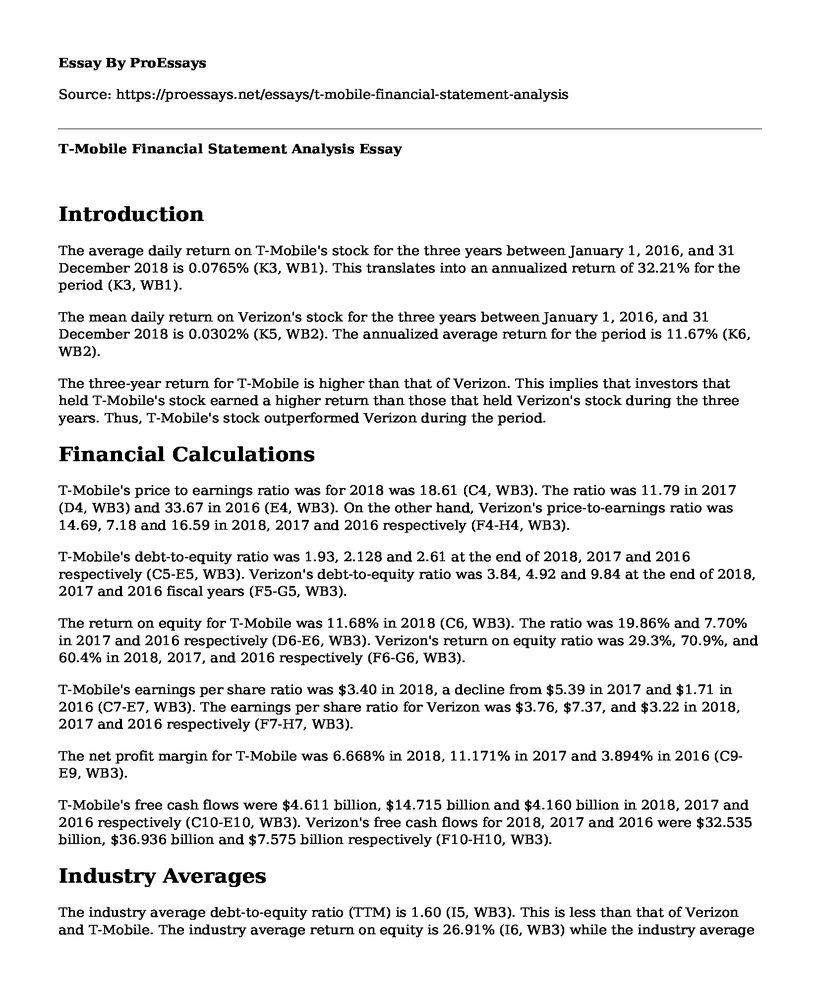Introduction
The average daily return on T-Mobile's stock for the three years between January 1, 2016, and 31 December 2018 is 0.0765% (K3, WB1). This translates into an annualized return of 32.21% for the period (K3, WB1).
The mean daily return on Verizon's stock for the three years between January 1, 2016, and 31 December 2018 is 0.0302% (K5, WB2). The annualized average return for the period is 11.67% (K6, WB2).
The three-year return for T-Mobile is higher than that of Verizon. This implies that investors that held T-Mobile's stock earned a higher return than those that held Verizon's stock during the three years. Thus, T-Mobile's stock outperformed Verizon during the period.
Financial Calculations
T-Mobile's price to earnings ratio was for 2018 was 18.61 (C4, WB3). The ratio was 11.79 in 2017 (D4, WB3) and 33.67 in 2016 (E4, WB3). On the other hand, Verizon's price-to-earnings ratio was 14.69, 7.18 and 16.59 in 2018, 2017 and 2016 respectively (F4-H4, WB3).
T-Mobile's debt-to-equity ratio was 1.93, 2.128 and 2.61 at the end of 2018, 2017 and 2016 respectively (C5-E5, WB3). Verizon's debt-to-equity ratio was 3.84, 4.92 and 9.84 at the end of 2018, 2017 and 2016 fiscal years (F5-G5, WB3).
The return on equity for T-Mobile was 11.68% in 2018 (C6, WB3). The ratio was 19.86% and 7.70% in 2017 and 2016 respectively (D6-E6, WB3). Verizon's return on equity ratio was 29.3%, 70.9%, and 60.4% in 2018, 2017, and 2016 respectively (F6-G6, WB3).
T-Mobile's earnings per share ratio was $3.40 in 2018, a decline from $5.39 in 2017 and $1.71 in 2016 (C7-E7, WB3). The earnings per share ratio for Verizon was $3.76, $7.37, and $3.22 in 2018, 2017 and 2016 respectively (F7-H7, WB3).
The net profit margin for T-Mobile was 6.668% in 2018, 11.171% in 2017 and 3.894% in 2016 (C9-E9, WB3).
T-Mobile's free cash flows were $4.611 billion, $14.715 billion and $4.160 billion in 2018, 2017 and 2016 respectively (C10-E10, WB3). Verizon's free cash flows for 2018, 2017 and 2016 were $32.535 billion, $36.936 billion and $7.575 billion respectively (F10-H10, WB3).
Industry Averages
The industry average debt-to-equity ratio (TTM) is 1.60 (I5, WB3). This is less than that of Verizon and T-Mobile. The industry average return on equity is 26.91% (I6, WB3) while the industry average net profit margin (TTM) is 9.63% (I9, WB3).
T-Mobile's debt-to-equity ratio at the end of 2018 was 1.93 (C5, WB3) indicating that its total liabilities. It implies that the company's financial health is weak since it has higher leverage (Gibson, 2013). Debt holders have a greater claim on T-Mobile's assets than shareholders (Gibson, 2013). The company's debt-equity ratio has declined over the last three years showing an improvement in T-Mobile's financial health. Verizon's debt-equity ratio at the end of 2018 was 3.84 (F5, WB3) indicating that its total liabilities were more than thrice the value of its total equity. It shows its leverage is high; hence its financial health is weak (Subramanyam, 2014). The ratio declined in both 2017 and 2018 implying that the financial health of Verizon improved in the last two years.
The debt-equity ratio for T-Mobile was less than that of Verizon in each of the last three years. This suggests that T-Mobile is more financially stable than Verizon. Its long-term solvency is higher than that of Verizon (Subramanyam, 2014).
Performance Over Time
T-Mobile's performance improved in 2017 but declined in 2018. Its net profit margin for 2018 was 6.668% indicating that it generated a net income of 6.7 cents per dollar of total revenue (Gibson, 2013). The ratio increased in 2017 but declined in 2018. The return on equity ratio also increased in 2017 but dropped in 2018. This shows that the profitability of T-Mobile improved in 2017 but fell in 2018. The decline in its performance in 2018 is also shown by the fall in its free cash flows.
The ratios and free cash flows indicate that Verizon's performance improved in 2017 followed by a decline in 2018. Verizon's net profit margin and return on equity increased in 2017 before declining in 2018. This shows that the profitability of the company deteriorated in 2018 (Subramanyam, 2014).
The data shows that Verizon is more profitable than T-Mobile since it has higher profit margins and return on equity ratios. Besides, Verizon generated more free cash flows than T-Mobile in each of the last three years. This is because Verizon is bigger than T-Mobile as shown by the total revenue earned and total assets in each of the last three years.
Investment
T-Mobile is a growth stock while Verizon is a value stock. As shown by the three-year return, T-Mobile's stock generated a higher return than Verizon. Thus, its investors rely more on future stock appreciation for returns. On the other hand, the stock of Verizon's stock generated a lower three-year return but higher profit. Its earnings per share were greater than T-Mobile's.
The analysis shows that Verizon is a better stock than T-Mobile. Its profitability is higher than that of T-Mobile. It also generated higher free cash flows than T-Mobile. Besides, its price-to-earnings ratio was lower than that of T-Mobile suggesting that it is undervalued (Gibson, 2013).
References
Gibson, C. (2013). Financial statement analysis. Mason, Ohio: South-Western.
Subramanyam, K. (2014). Financial statement analysis. New York, NY: McGraw-Hill.
Cite this page
T-Mobile Financial Statement Analysis. (2022, Nov 17). Retrieved from https://proessays.net/essays/t-mobile-financial-statement-analysis
If you are the original author of this essay and no longer wish to have it published on the ProEssays website, please click below to request its removal:
- Paper Example on Accounts Receivable Cycle in Healthcare
- Alternative Service Delivery Offered by the Wema Bank ALAT System
- TIBO Outsourcing Practice and Security Risks Analysis Paper Example
- Baking Supplies Cost Estimate: Dinerstein's Prices Essay Example
- IMF & WB: Criticisms & Conditionality Policy - Essay Sample
- Essay Example on Government Health Insurance Programs: Coverage & Eligibility
- Essay Example on Current US GDP & Federal Debt: 85.91 Trillion & ~23.17 Trillion Respectively







